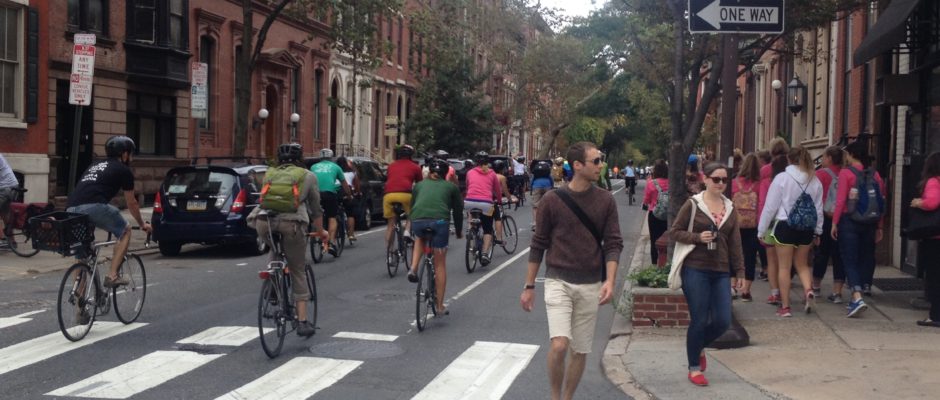As Philadelphia braces for the upcoming Democratic National Convention, a lot of locals are thinking back to the city’s last big public event: the visit by Pope Francis.
During the lead up, the Pontiff’s September visit was widely dubbed “Pope-amageddon.” Media and government officials issued apocalyptic warnings about everything from traffic to security. Elective surgeries were postponed and pregnant women made plans to deliver away from downtown hospitals. Much of Center City was cordoned off and closed to traffic. National Guard troops were stationed at every corner. With the city on lockdown, a lot of Philadelphians got the message: they fled while they could.
For those who remained, the weekend became a glorious, take-back-the-streets happening. Thousands of bicyclists pedaled together in a massive ride, people played Frisbee and football in the middle of Market Street, and pedestrians, strollers and dogs promenaded to the music of visiting pilgrims.
But businesses suffered. The Philadelphia Inquirer reported drastic drops in restaurant and retail sales in the heart of the city (though downtown hotels did well).
Things will be different when the Democrats convene July 25-28. It’s the dog days of summer — a lot of Philadelphians are already down-the-shore or elsewhere on vacation — and most of the action will occur in deep South Philadelphia near the Wells Fargo Center.
And most notably, the city has a new mayor who seems determined to avoid a mass exodus. In fact, Mayor Jim Kenney is actively urging residents to stay.
“I know for many a July trip to the shore is pretty appealing,” Kenney wrote in an op-ed published June 27 in the Inquirer. “But trust me, Philadelphia, you don’t want to miss this.”
According to spokeswoman Lauren Hitt, the administration is aggressively de-emphasizing any inconveniences — away from the immediate stadium district, the impact on everyday city life should be minimal. The city expects around 50,000 visitors, about the equivalent of the annual Army-Navy game. There will be a security perimeter around the Wells Fargo Center, but no extended road or highway closures outside of the stadium district. SEPTA plans expanded Broad Street line service to accommodate the delegates.
As for security, “We feel well prepared from a public safety stand-point,” says Hitt. FDR Park in South Philadelphia has been designated as the official protest staging area, but protests also being planned for Center City.
And the administration isn’t content just to promise a hassle-free convention, they are also promoting a dynamic slate of events. Visitors and residents alike can check out Philly Feast, a food-truck festival happening July 25, 11 a.m. to 3 p.m. at 3rd and Arch Streets in Old City. On July 27, a huge Center City Sips happy hour will take place at Dilworth Plaza, Comcast Plaza and Centre Square. The family-friendly PoliticalFest, a hit at the 2000 GOP convention in Philadelphia, will return July 22 and 27 at seven participating locations.
For political junkies, many of the smaller caucuses and daytime convention events are open to the public, and an array of panel discussions is scheduled. Bars, restaurants and venues across the city have planned watch parties for the final night, July 28, when Hillary Clinton formally accepts the nomination.
To help boost the local economy, the DNC has created #DNCDeals, a Twitter hashtag campaign for businesses to publicize deals, events and special menus during the convention.
And the city will look spiffy. A public art installation of 57 fiberglass donkeys, each painted by a local artist to represent a different delegation, adorn the streets. Center City District, a private-sector improvement organization, promises extra street cleanings and signage. The City of Philadelphia Mural Arts Program has installed a mile-long mural along South Broad Street. The Pennsylvania Horticultural Society is doing extra planting around Center City.
“We want to encourage folks to stay in town and enjoy the event,” enthuses Hitt. “There will be a lot of energy. It’s a historical moment for the city and the country.”
ELISE VIDER is news editor of Keystone Edge.
